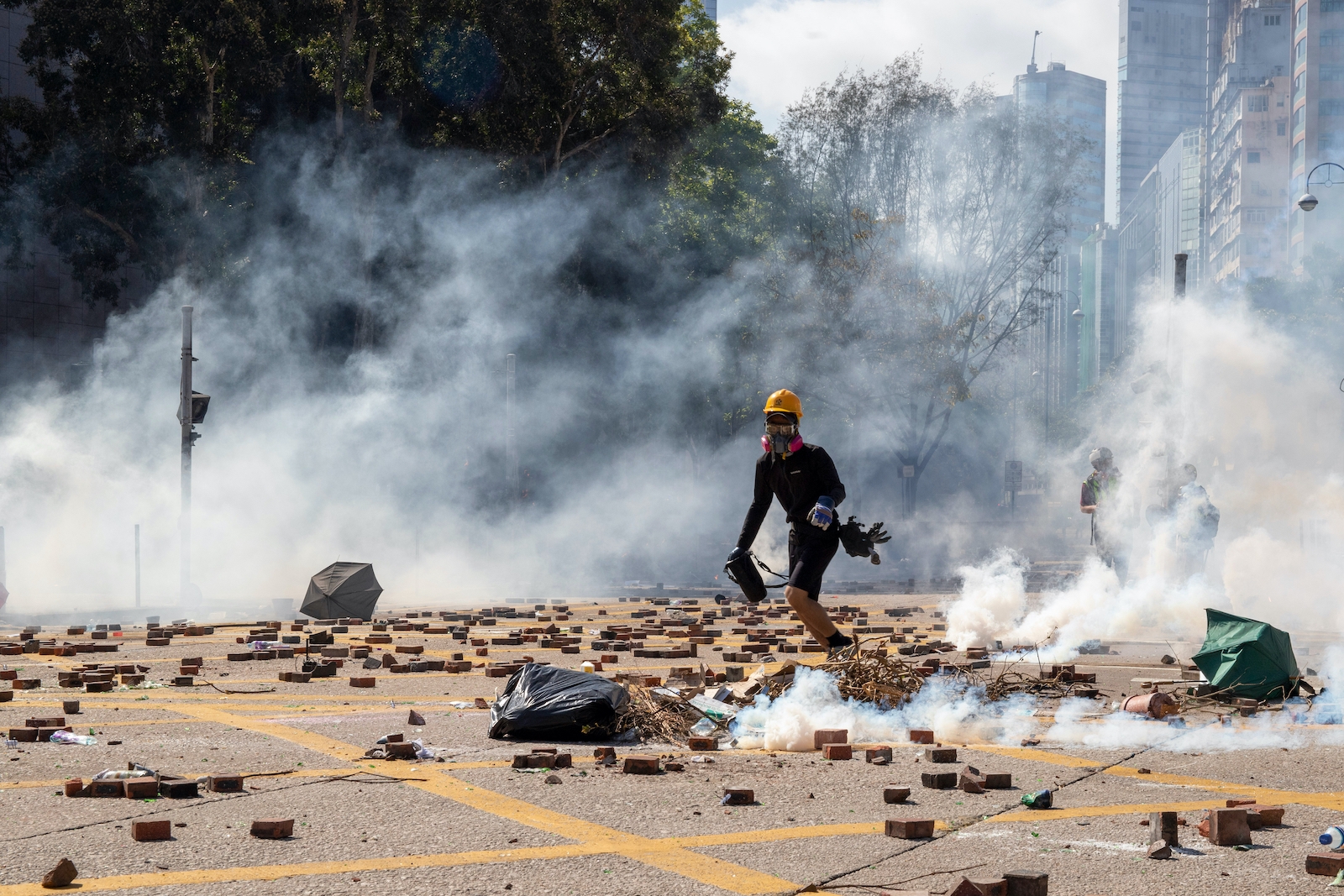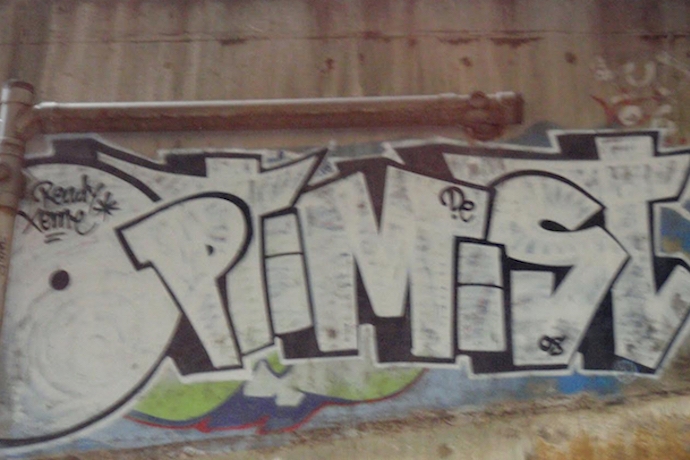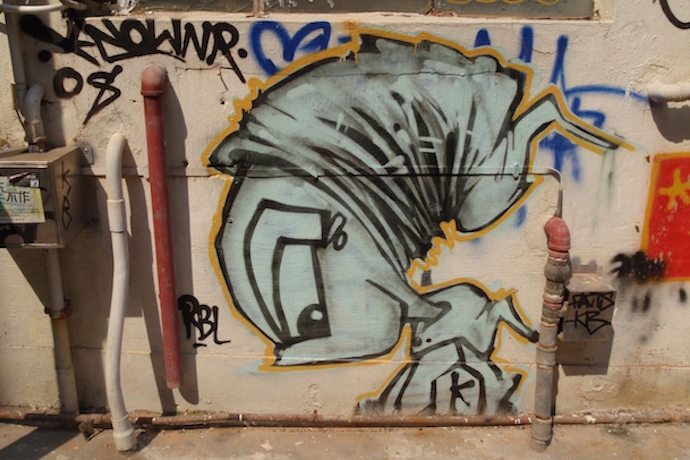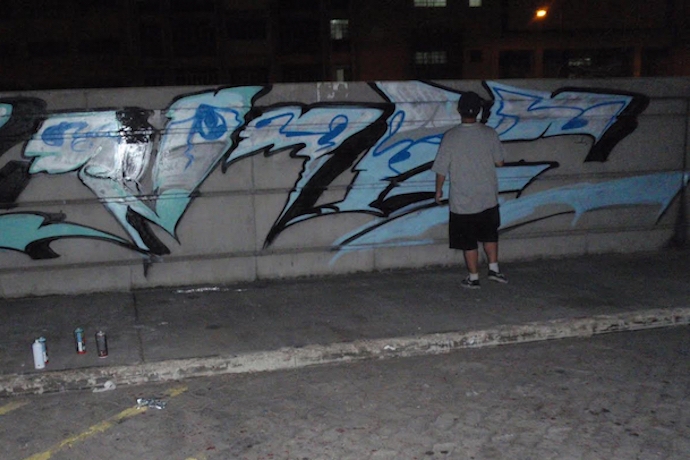
Vigils and Vandalism: How Hong Kong’s Graffiti Artists can help us Understand the Protesters
Six years ago standing under an overpass in Hong Kong, spray paint fumes heavy in the air, I chatted with Round, one of Hong Kong’s most prolific graffiti artists. She explained, “I used to use [spray] cans, but now I work mostly with rollers and brushes. A lot of the European and American graff artists say I am not doing graff. I don’t care. I paint for me. Graffiti is about expressing yourself, breaking rules, so how can they tell me that I am not doing it the right way.”
I heard these sentiments in 2008 while researching the social and political aspects of graffiti in Hong Kong and China. In 2014 after seeing headlines fixated on the peacefulness and civility of protesters in Hong Kong, some even arguing it’s counterproductive, I cannot help but think that the groups gathered throughout Hong Kong might share Round’s sentiments. As the recently publicized disagreement over methods amongst protestors in Hong Kong shows, even those in the same movement cannot necessarily agree on a “right way.”
When observing behavior, be it groups holding placards for democracy or individuals spray-painting walls in the night, you can learn a lot more through trying to see how actions make sense in their context than by focusing on how divergent they would seem in yours.
The situation in Hong Kong is different than in Europe, America, or anywhere else. Many of the graffiti artists I met in Hong Kong and China talked about how European and American graffiti artists disparaged them for not painting trains or other high-profile places. As the Hong Kongese and Chinese artists explained, “They don’t understand. Your [the American/European] government will try to find you, ours will find us.”
Although likely apocryphal, I was told of a Chinese artists who painted a train once; he flew to another city in China for just one day to do it. Upon returning home he received a call from the police and was sentenced to 5 years in prison for “actions against the state.” Whether the stories are true or not, the concerns of artists are the same.

Graffiti artists in Hong Kong didn’t paint many high-profile places. Most pieces I saw were in places like back alleys, more secluded courtyards, or under bridge overpasses. I never saw a train that was painted. When I did see tags on buildings or signs in areas that received heavy foot traffic it was usually the work of FHK, a crew of French graffiti artists living in Hong Kong. The severe penalties that can result from painting in the wrong place in Hong Kong or China are only part of the explanation as to why Hong Kongese and Chinese graffiti artists aren’t sneaking around train yards or running from the police after painting up high street. Such daring acts are central to the canon of American and European graffiti. Context influences people’s behaviors through differences in consequences faced as well as the history and culture that provides motivation for actions. This is true of graffiti as well as protesting.
American and European artists are well known for flouting the law to get their art up. More than just a matter of necessity to avoid fines or arrest for doing graffiti, opposition to authority and the police has been a part of American and European graffiti culture since its beginnings in ‘70s New York. Modern graffiti, and the wider culture of hip-hop that it developed as part of, emerged from the impoverished, crime-filled, and disenfranchised ghettos of the Bronx. Prior to its adoption as a foundational element of hip-hop culture in the ‘70s, graffiti was predominantly used by gangs to mark their territory.
Even after graffiti ceased to be mainly a gang activity and became a key element of hip-hop and individual expression it was for many years largely confined to low-income, high crime areas of cities. Graffiti matured amongst populations and in a context–youth in the ghettos of America and then Europe–ignored by society at large and excluded from economic and social opportunity. Crime was part of life for many of those active in graffiti and hip-hop more broadly; a fact often referenced in the music as well as the art of hip-hop. An almost belligerent attitude about putting graffiti pieces in the face of the general public and disregard for the law were built into the DNA of graffiti.
While graffiti is now practiced by people of all social stratum and backgrounds, American and European graffiti artists are inheritors of a tradition in which painting where you shouldn’t and evading the law are, for many, part of the art just as much as the style of your letters or the way you contrast colors.
Hong Kongese and Chinese graffiti artists were aware of what would be tolerated by the authorities and their community and what wouldn’t. They stayed mostly on the acceptable side of the line.

Unlike in the US, graffiti in Hong Kong has no history of use by gangs. The Triad, the mafia-like gang in Hong Kong and China, I was told, “doesn’t bother with spray paint they are busy making money.” They don’t need to mark territory either because, as was explained to me, they are centrally organized with different groups’ areas being decided through internal politics so everyone knows who controls where.
None of the graffiti artists I met in Hong Kong or China were from impoverished crime-filled neighborhoods of the likes found in the Bronx or Compton. Many were students at or graduates from university art programs and came from relatively well-off families. These were not the same disenfranchised youth afforded few opportunities that birthed America and Europe’s graffiti culture. They did not have the same motivating factors to breed antagonism towards society and the police. On the contrary, they were raised in communities that placed a high value on supporting social order and respecting the law. As so often cited in articles about the protestors in Hong Kong, the population of Hong Kong is renowned for it orderliness and adherence to the law.
These artists were pursuing a route for their art, sticking to more secluded places and doing more detailed pieces, whereby they could paint while still being respectful of their wider society. This was appreciated by many citizens I spoke with who often commented that they didn’t mind and even enjoyed the graffiti pieces they saw in alleys and courtyards. What they didn’t like was the “vandalism on the big streets that makes the city look dirty.”
While some of the Hong Kongese and Chinese artists voiced regret that they had not, and did not feel that they could, paint trains it was always expressed as a longing to take part in this quintessential graffiti action. These graffiti artists were not provocateurs; they seemed most interested in enjoying doing their art.
It is understandable why Hong Kongese and Chinese artists would be reticent to paint trains or otherwise push the line with the authorities. They face stiff penalties. They lack the context and history that leads their American and European counterparts to value the disruptive and criminal aspects of graffiti. If the artists did begin painting trains and all over the city it would likely quickly lead to the end of the relative freedom they currently enjoy to paint in low profile areas.

A well-known Danish graffiti artist who lived in Hong Kong through the start of graffiti there warned me that a crackdown was coming. “People don’t like when graffiti becomes too much, pushes to far. If the graff artists [mostly expatriate artists] here keep throwing up tags, making the city look dirty, the hammer will come down. Everyone will be swept up, those vandalizing the city and those making the art that people like. Then goodbye graffiti in Hong Kong.”
Hong Kongese and Chinese graffiti artists were painting because they enjoyed doing it and they understood the situation they were in. They understood what they had to do to continue being able to paint. They weren’t clueless individuals not doing graffiti right, they were doing graffiti in the way that fit the constraints of their context and the graffiti culture that had emerged from that context.
I see similar misunderstanding in some of the assessments of the protestors. In calling the Hong Kong protesters overly pacifistic commentators are comparing to events that occurred in very different cultural and political contexts evaluating the actions of groups with very different expectations.
Tiananmen Square protesters in 1989 were met with bullets and tanks. Even the “excessively” peaceful protesters in Hong Kong have had tear gas used on them by the police. A group of demonstrators’ attempts to break into Hong Kong’s Legislature resulted in at least 6 arrests. Wenwei Po, a Hong Kong Newspaper, wrote that Civic Passion, a group affiliated with this action, should be classed as a terrorist group and its leader punished by the courts. If the Hong Kong protesters were to escalate violence, throw rocks or overturn police cars, how long before Beijing felt the need to end the situation and all the protesters were in prison? Who would speak for expanding democracy in Hong Kong then? The warnings from Beijing that democracy will lead to chaos and that protesters are just looking to disrupt peace would only be confirmed to a wary public and the protester’s ideas discredited.
Extreme actions and risks are often necessary to bring political change as seen in Egypt, Libya, and countless other countries. But the protesters in Hong Kong are there to demand more open democracy in light of recent electoral reforms that maintain Beijing’s control on candidates for the chief executive election in Hong Kong, not to overthrow the government. Even referencing the protester’s actions as the “Umbrella Revolution” may be undermining their cause by making them appear more extreme than they are. The issues raised by the protestors are vital issues. The democratic freedom protester’s desire cannot be complete until electoral reform has occurred. Open revolution, however, would likely end in defeat, harm their cause, and harm those involved. Peaceful expression, adherence to values of order, and reasoned requests for political change are far more dangerous weapons in the arsenal of Hong Kong’s protestors than violent disruption.

Beyond the challenges presented by the government, the protesters in Hong Kong are navigating a public wary of their methods and not necessarily inspired by their goals. Raised under the same cultural values of order and civility, many of the protesters seem to be put off by disrupting others and the order of Hong Kong. The protestors are not supported by a majority of Hong Kong’s residents. A poll conducted in October by the Chinese University of Hong Kong identified an almost even split between respondents that support (37.8%) and oppose (35.5%) the “Occupy Movement.” Protesters must allay the concerns other residents may have before the protesters have a chance of changing minds.
Beijing has long fanned concerns that democracy would bring chaos and stifle the growth of Hong Kong. Mainland news sources, when they do report on the protests, emphasize the disruption to things like transit and stock values they are causing. By exhibiting restraint–apologizing for the inconvenience they have caused others, allowing government workers to pass unbothered to work–protesters are providing evidence of civility and order existing alongside democratic goals. The protesters are showing that they are good neighbors, that they will not bring chaos and disrupt life, that they also value a collaborative responsible community contradicting reports from Beijing.
They are not just conforming to the values of other citizens, they are protesting in a way that conforms with their own values, their own vision of what democracy should be. The OCLP’s, key organizers of the protest, released a manual entitled the “Manual of Disobedience” days before the occupation began that provides guidance on how to protest in an effective way that aligns with the movement’s values.
They are not pushing too far. They are embodying the values that they share with their neighbors at the same time that they are expressing values that may not be shared. They are savvy actors adept at navigating a challenging situation.
Standing under that overpass 6 years ago Round came and stood next to me looking at the lights of Central District over Kowloon Bay. “Hong Kong is a confusing place. We, I don’t really know what I am. Am I British, Chinese, Hong Kongese? What does any of that even mean? I paint to try and figure out who I am and what it means to be me.” Hong Kong is a confusing place. Pulled between many different cultures, histories, and values that aren’t standing still long enough to be pinned down. Whatever motivates the protesters in Hong Kong to pick up their garbage and apologies for asking for greater democracy I am sure that the form of their actions is shaped by and shaping what it means to live in Hong Kong.
Names have been changed to protect the identities of those interviewed.

